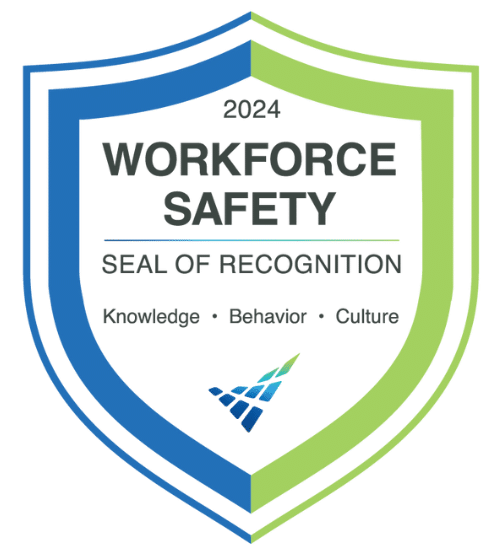January 5, 2024 7 min read

Creating Blended Learning Strategies for Online Safety Training
Industry:
Solution:

There is no magic bullet to training success. Modern workforce training programs must be engaging, scalable, and, most importantly, effective. So, there is no single strategy that achieves all training objectives. But countless studies show that blended learning strategies outperform any other (such as only instructor-led or only eLearning). So, if you want to build a training strategy for your industrial manufacturing workforce, it’s time to consider a blended learning approach!
Keep reading for some actionable tips to create an effective blended training strategy.
What is Blended Learning?
Blended learning (also called hybrid learning) is an educational approach that combines both in-person instruction with online training.
This training method combines the benefits of instructor-led classes (employees can ask questions, collaborate, and deepen their understanding) with the benefits of eLearning (scalability, time savings, and accessibility).
Hybrid learning approaches are also more flexible for learners, making them a very attractive solution for training all employees across various shifts and work locations.
Employees can learn at their own pace. Organizations can save money and increase knowledge retention. It’s a win-win.
What is an Example of Blended Learning?
Safety training is a great example of how to use blended learning. For example, if you were creating a blended learning training solution on Hazard Communication, you might include:
- An online safety training course that covers fundamental information about Haz-Com signal words, label elements, and safety data sheets (SDS).
- Classroom, instructor-led training about the hazardous chemicals at your workplace, where the safety data sheets are kept, an opportunity to answer employee questions, and assessments to determine if employees can perform the necessary duties on the job.
What Are the Different Types of Blended Learning?
Because Blended Learning is inherently a flexible learning model, there are five main ways you can approach it:
- The Flipped Model. This approach inverts traditional classroom instruction. Your employees will first use online training and then come into a classroom to dive deeper. This allows your classroom time to focus more on collaborative activities, discussions, and exercises that reinforce knowledge.
- Face-to-Face Driver Model. This model is where the majority of training is instructor-led in a classroom. Typically, the virtual learning component can be done in the classroom with an instructor there to offer personalized support. Note that this approach does not offer the same cost and time savings and is often impractical for larger organizations.
- Rotational Model. In this approach, learners will alternate between in-person and online instruction on a set schedule. For instance, a learner might go to class Tuesday and Thursday but have online training time Monday, Wednesday, and Friday. Like the Flipped Model, classroom time is spent on discussions and projects to deepen knowledge rather than “lectures.”
- Flex Model. Not surprisingly, this model is all about flexibility! In the Flex Model, learners have autonomy over how and when they learn. They have access to an online curriculum and then choose when they need in-person support and instruction. Although this is best for adapting to the needs of each individual learner, this model is harder to scale for larger companies.
- Enriched Virtual Model. This model leans heaviest on online training with much more periodic in-person training sessions. This model taps into the flexibility of the Flex Model but is much easier to scale.
Benefits of Blended Learning Strategies
There are numerous benefits of using a blended learning strategy for things like safety training.
- It’s required. OSHA compliance requirements forbid companies from only using online safety training. OSHA and safety are not boxes to check. Ensuring understanding and compliance can literally save lives and prevent injury.
- It saves time and money. The amount of safety and compliance training companies must train their employees on is vast. And the cost of taking employees off the floor for instruction adds up. Embracing a training model that uses online training can alleviate that cost.
- It’s more effective. All people benefit from flexibility and learning at their own speeds, which hybrid learning offers. And studies have shown that blended approaches to learning are more effective and can help beat “the training forgetting curve.”
How To Create a Blended Safety Training Strategy
Blended learning is the future of workforce training. Let’s review how to build a hybrid learning strategy from scratch.
1. Set Learning Goals
Any good strategy starts with defining SMART learning objectives. Understanding what your blended learning strategy should help you achieve will be invaluable in choosing a learning model and measuring the program’s success.
2. Choose Your Approach
The next step in creating your blended learning strategy is to choose your approach. Whatever blended learning model you choose, there are three main types to choose from:
- Online learning then classroom training
- Online training during classroom
- Classroom then online training (for either refresher training or performance support)
Each of these approaches has its benefits. For most organizations, online training being used in a classroom is the least feasible since it still requires a lot of face-to-face time.
We like the benefits of starting with online learning and having periodic classroom training to reinforce knowledge and provide support, but there are merits to starting with in-person instruction, too.
No matter what path you choose, just remember that spacing out training can help employees remember this critical safety content.
3. Choose the Right Online Training Vendor
Hybrid training works best when the online courses are high-quality, up-to-date, and engaging. At Vector Solutions, we believe in the power of 3D animation to make safety training more memorable and easier to understand. When selecting a vendor, ensure they:
- Update their content regularly to keep up with industry regulations
- Use cutting-edge animation styles to create engaging and effective training content
- Provide the breadth and depth of content needed to supplement in-person instruction
4. Implement, Measure, and Adapt!
Blended learning strategies are made to be flexible. After launching your hybrid training program, collect employee feedback and assess employee knowledge to learn if the program worked for your people.
No two companies are the same, so remember to keep adapting your training program until it achieves your initial objectives.
Blended Learning Solutions Guide
Learn strategies for developing effective blended learning solutions that increase knowledge retention, skill development, and job performance.
Download Guide
Why Choose Vector Solutions as Your Blended Learning Partner?
At Vector Solutions, we are on a mission to make people safer, smarter, and better. There is no better example of that than improving employee and workplace safety. Helping employees stay safe performing their critical functions is something we care deeply about, which is why we focus on creating award-winning safety content.
But we also believe in being an end-to-end partner that supports the unique needs of our customers. From our learning management system that was designed to support blended learning and custom curriculums to our EHS Management Software, we are ready to support your safety training and management needs.
Want to see these products in action? Request a demo today.











